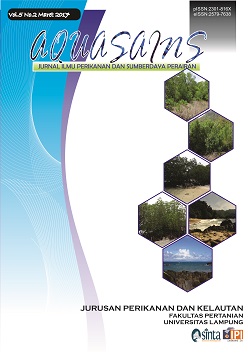EFFECTIVITY OF LIGHT INTENSITY ON COLOR GRADATION AND CAROTENOIDS CONTENT OF Lobophyllia hemprichii
Abstract
L. hemprichii is one of the marine ecosystems with high biodiversity and the most productive. The more healthy corals, the higher productivity in the sea. The existence of light is needed for L. hemprichii for its growth. Moreover L. hemprichii has color that produced by symbiotic algae pigments such as carotenoid pigments. Carotenoid pigment has active role to absorb light in process of photosynthetic of algae symbionts. The aims of this study were to gain different effects of light intensity to color gradation of red and carotenoids content of L. hemprichii. The study was conducted by placing L. hemprichii into aquriums with ICR treatment (Low Light Intensity = 1514 Lux), ICS treatment (Medium Light Intensity = 3028 Lux), treatment ICR (High Light Intensity = 4547 Lux). The results showed that the light intensity affect the color gradation of coral L. hemprichii and light intensity affect the concentration of total carotenoid pigment L. hempirchii. The best light intensity for L. hempirchii color and carotenoid pigment production was high light intensity (4547 Lux).Downloads
Download data is not yet available.
Downloads
Published
2017-04-07
How to Cite
Mustawa, A., Harpeni, E., & Muhaemin, M. (2017). EFFECTIVITY OF LIGHT INTENSITY ON COLOR GRADATION AND CAROTENOIDS CONTENT OF Lobophyllia hemprichii. AQUASAINS, 5(2), 521–526. Retrieved from https://jurnal.fp.unila.ac.id/index.php/JPBP/article/view/1436
Issue
Section
Articles
License
License for Authors
Authors who publish with this journal agree to the following terms:
- Authors retain copyright and grant the journal right of first publication with the work simultaneously licensed under a Creative Commons Attribution License that allows others to share the work with an acknowledgement of the work's authorship and initial publication in this journal.
- Authors are able to enter into separate, additional contractual arrangements for the non-exclusive distribution of the journal's published version of the work (e.g., post it to an institutional repository or publish it in a book), with an acknowledgement of its initial publication in this journal.
- When the article is accepted for publication, its copyright is transferred to Aquasains Journal. The copyright transfer convers the exclusive right to reproduce and distribute the article, including offprint, translation, photographic reproduction, microfilm, electronic material, (offline or online) or any other reproduction of similar nature.
- Authors are permitted and encouraged to post their work online (e.g., in institutional repositories or on their website) prior to and during the submission process, as it can lead to productive exchanges, as well as earlier and greater citation of published work (See The Effect of Open Access).
- The Author warrant that this article is original and that the author has full power to publish. The author sign for and accepts responsibility for releasing this material on behalf os any and all-author. If the article based on or part os student’s thesis, the student needs to sign as his/her agreement that his/her works is going published.
License for Regular Users
Other regular users who want to cite, distribute, remix, tweak, and build upon author’s works, even for commercial purposes, should acknowledge the work’s authorship and initial publication in this journal, licensed under a Creative Commons Attribution License.
This license lets others distribute, remix, tweak, and build upon your work, even commercially, as long as they credit you for the original creation.
This work is licensed under a Creative Commons Attribution 4.0 International License.Copyright Transfer Statement can be downloaded here


.png)









